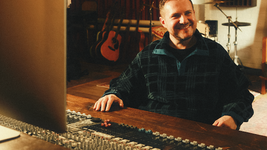Icon (Cherkaoui & Gormley), GöteborgsOperans Danskompani - Sadler's Wells Theatre
- Stephanie Burrell
- Dec 1, 2018
- 3 min read
Sidi Larbi Cherkaoui has conceptualised a dualistic work that Sadler’s Wells has revived for one evening. Icon that first premiered in 2016 in Sweden, forcibly grounds both the dancer and the spectator, not only with its tactile and visceral scenography but also with its profound text. Pleasing notes of interdisciplinary-work adorn the piece as Antwerp-based fashion designer Jan-Jan Van Essche and famous sculptor Antony Gormley have essential roles within the pieces’ conception and formation. Iconinvestigates the desire to make and unmake, construct and deconstruct on both individual and societal levels.

Icon - Sidi Larbi Cherkaoui & Antony Gormley - GöteborgsOperans Danskompani
The breadth of movement within Icon compliments the themes, text and scenography beautifully. Choreographer Sidi Larbi Cherkaoui modestly imprints his trademark style on to GöteborgsOperans Danskompani, although, Cherkaoui still allows individualism to thrive and prosper. The masse of eighteen dancers are able to emanate a dualistic energy between giving and indulging, a notion signature to the choreographer’s work. They smoothly transition between one group and many smaller ones, the dancers’ forearms connect this corporeal community, which undulates and ripples through all the bodies. Self-indulgent head roles and angular arm motifs, that dissect the dancers body on different planes of their kinesphere, diluted the outward and giving movements. The militaristic and total dedication that the dancers give to following their gaze adorned the choreography. Slowly, the dancers begin to look hypnotised as their body follows the weight of the head, this dominos effect warped the way their limbs stretched also. These arbitrary moments of individualism contrast the meta-structures and physicality that the whole group created.

Icon - Sidi Larbi Cherkaoui & Antony Gormley - GöteborgsOperans Danskompani
The continuous exchange between grand moments of mass bodies connected to smaller groups and eventually solo work reflects the idea expressed by the choreographer that “idols and icons that can be superseded”. A virtuoso B-Boy solo emerges that shatters the exhausted stereotypes of contemporary dance; for example pedestrian-like interaction. Consequently, the solo enriches Gormley’s and Cherkaoui’s thematic approach. Furthermore, dynamic and swift spins on his knee and instep of the sole of the foot nod to the B-Boy battles on the streets of New York, which were constant battles to see which dancing agent would supersede the other. There is a fluidity between influencer and those being influenced in Icon, as this solo is watched attentively by the other dancers and then enveloped by the group, these hidden details, that the audience must decipher, surface due to Cherkaoui’s sublime direction.
Intimacy and creativity characterise the relationship between choreographer and sculptor. The symbiosis of choreography and interactive sculpture is a testament to their collaborative art. Gormley quotes 'When you see dancers interact with the clay, it speaks volumes about who they are as individuals'. Stamping, bashing, scratching and moulding are actions that the dancers impose upon the clay, almost as if the clay serves as a medium for them to imprint their own introspective reality. Self-empowered agency that demands representation is further articulated through the varied score. Traditional weaver’s songs from Amami, Japan and bespoke arrangements of pop such as Cheap thrills by Sia were an accompanying manifesto of identity and self. The clay also mimicked embryonic-like sacks that initiated the rebirth of the dancers this signalled how in today's society an icon or star can be easily made.
Icon celebrates how loss and demolition can be euphoric and catastrophic. Thematically, this was well represented through the vast and deep-rooted exploration between dancer and malleable and interactive scenography.
























































Comments